Rama Chellappa
MS-GS: Multi-Appearance Sparse-View 3D Gaussian Splatting in the Wild
Sep 19, 2025Abstract:In-the-wild photo collections often contain limited volumes of imagery and exhibit multiple appearances, e.g., taken at different times of day or seasons, posing significant challenges to scene reconstruction and novel view synthesis. Although recent adaptations of Neural Radiance Field (NeRF) and 3D Gaussian Splatting (3DGS) have improved in these areas, they tend to oversmooth and are prone to overfitting. In this paper, we present MS-GS, a novel framework designed with Multi-appearance capabilities in Sparse-view scenarios using 3DGS. To address the lack of support due to sparse initializations, our approach is built on the geometric priors elicited from monocular depth estimations. The key lies in extracting and utilizing local semantic regions with a Structure-from-Motion (SfM) points anchored algorithm for reliable alignment and geometry cues. Then, to introduce multi-view constraints, we propose a series of geometry-guided supervision at virtual views in a fine-grained and coarse scheme to encourage 3D consistency and reduce overfitting. We also introduce a dataset and an in-the-wild experiment setting to set up more realistic benchmarks. We demonstrate that MS-GS achieves photorealistic renderings under various challenging sparse-view and multi-appearance conditions and outperforms existing approaches significantly across different datasets.
Polysemantic Dropout: Conformal OOD Detection for Specialized LLMs
Sep 04, 2025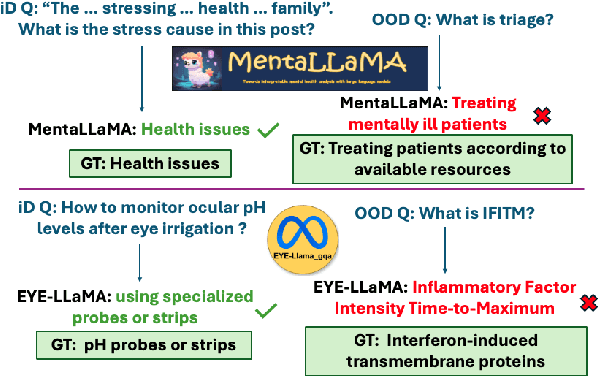

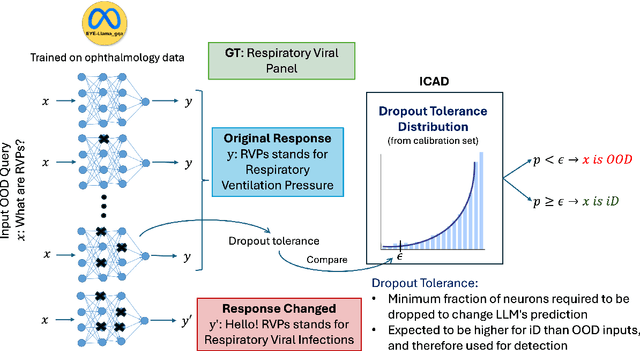

Abstract:We propose a novel inference-time out-of-domain (OOD) detection algorithm for specialized large language models (LLMs). Despite achieving state-of-the-art performance on in-domain tasks through fine-tuning, specialized LLMs remain vulnerable to incorrect or unreliable outputs when presented with OOD inputs, posing risks in critical applications. Our method leverages the Inductive Conformal Anomaly Detection (ICAD) framework, using a new non-conformity measure based on the model's dropout tolerance. Motivated by recent findings on polysemanticity and redundancy in LLMs, we hypothesize that in-domain inputs exhibit higher dropout tolerance than OOD inputs. We aggregate dropout tolerance across multiple layers via a valid ensemble approach, improving detection while maintaining theoretical false alarm bounds from ICAD. Experiments with medical-specialized LLMs show that our approach detects OOD inputs better than baseline methods, with AUROC improvements of $2\%$ to $37\%$ when treating OOD datapoints as positives and in-domain test datapoints as negatives.
TOGA: Temporally Grounded Open-Ended Video QA with Weak Supervision
Jun 11, 2025
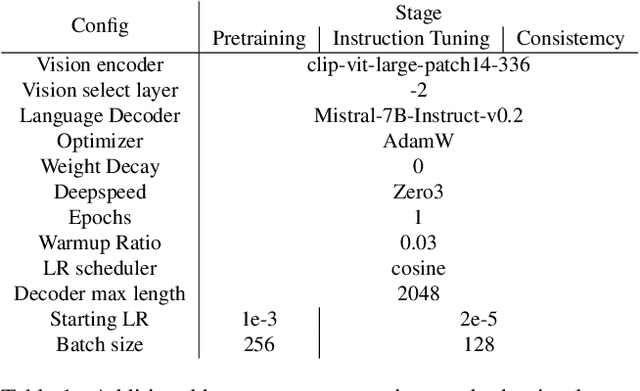
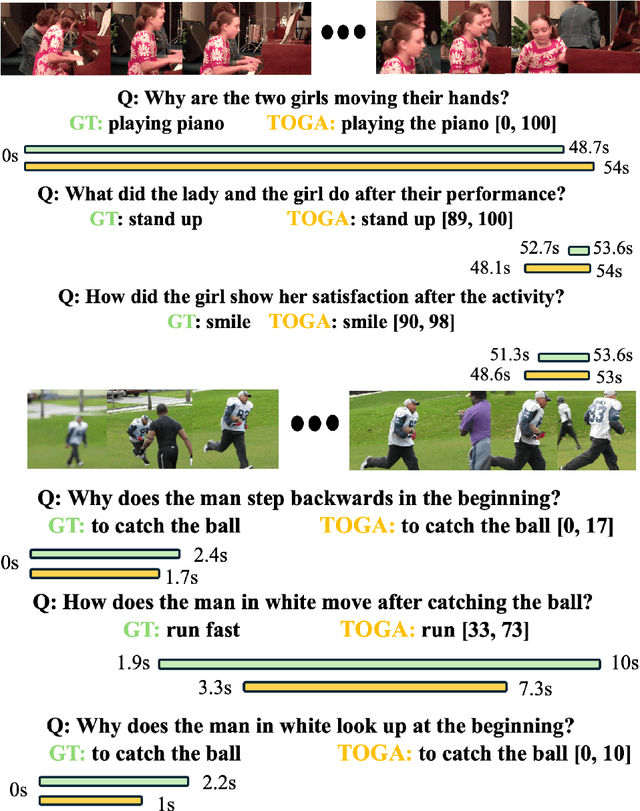
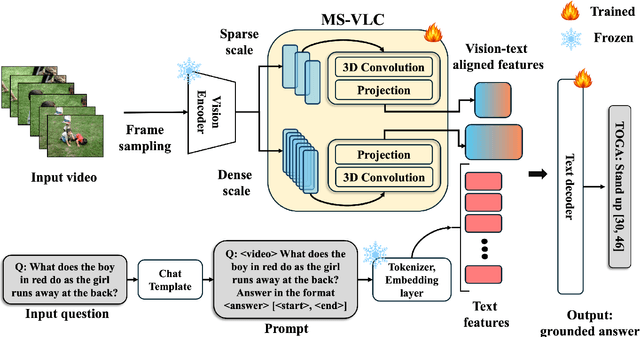
Abstract:We address the problem of video question answering (video QA) with temporal grounding in a weakly supervised setup, without any temporal annotations. Given a video and a question, we generate an open-ended answer grounded with the start and end time. For this task, we propose TOGA: a vision-language model for Temporally Grounded Open-Ended Video QA with Weak Supervision. We instruct-tune TOGA to jointly generate the answer and the temporal grounding. We operate in a weakly supervised setup where the temporal grounding annotations are not available. We generate pseudo labels for temporal grounding and ensure the validity of these labels by imposing a consistency constraint between the question of a grounding response and the response generated by a question referring to the same temporal segment. We notice that jointly generating the answers with the grounding improves performance on question answering as well as grounding. We evaluate TOGA on grounded QA and open-ended QA tasks. For grounded QA, we consider the NExT-GQA benchmark which is designed to evaluate weakly supervised grounded question answering. For open-ended QA, we consider the MSVD-QA and ActivityNet-QA benchmarks. We achieve state-of-the-art performance for both tasks on these benchmarks.
Test-Time-Scaling for Zero-Shot Diagnosis with Visual-Language Reasoning
Jun 11, 2025Abstract:As a cornerstone of patient care, clinical decision-making significantly influences patient outcomes and can be enhanced by large language models (LLMs). Although LLMs have demonstrated remarkable performance, their application to visual question answering in medical imaging, particularly for reasoning-based diagnosis, remains largely unexplored. Furthermore, supervised fine-tuning for reasoning tasks is largely impractical due to limited data availability and high annotation costs. In this work, we introduce a zero-shot framework for reliable medical image diagnosis that enhances the reasoning capabilities of LLMs in clinical settings through test-time scaling. Given a medical image and a textual prompt, a vision-language model processes a medical image along with a corresponding textual prompt to generate multiple descriptions or interpretations of visual features. These interpretations are then fed to an LLM, where a test-time scaling strategy consolidates multiple candidate outputs into a reliable final diagnosis. We evaluate our approach across various medical imaging modalities -- including radiology, ophthalmology, and histopathology -- and demonstrate that the proposed test-time scaling strategy enhances diagnostic accuracy for both our and baseline methods. Additionally, we provide an empirical analysis showing that the proposed approach, which allows unbiased prompting in the first stage, improves the reliability of LLM-generated diagnoses and enhances classification accuracy.
Cross-Spectral Body Recognition with Side Information Embedding: Benchmarks on LLCM and Analyzing Range-Induced Occlusions on IJB-MDF
Jun 10, 2025Abstract:Vision Transformers (ViTs) have demonstrated impressive performance across a wide range of biometric tasks, including face and body recognition. In this work, we adapt a ViT model pretrained on visible (VIS) imagery to the challenging problem of cross-spectral body recognition, which involves matching images captured in the visible and infrared (IR) domains. Recent ViT architectures have explored incorporating additional embeddings beyond traditional positional embeddings. Building on this idea, we integrate Side Information Embedding (SIE) and examine the impact of encoding domain and camera information to enhance cross-spectral matching. Surprisingly, our results show that encoding only camera information - without explicitly incorporating domain information - achieves state-of-the-art performance on the LLCM dataset. While occlusion handling has been extensively studied in visible-spectrum person re-identification (Re-ID), occlusions in visible-infrared (VI) Re-ID remain largely underexplored - primarily because existing VI-ReID datasets, such as LLCM, SYSU-MM01, and RegDB, predominantly feature full-body, unoccluded images. To address this gap, we analyze the impact of range-induced occlusions using the IARPA Janus Benchmark Multi-Domain Face (IJB-MDF) dataset, which provides a diverse set of visible and infrared images captured at various distances, enabling cross-range, cross-spectral evaluations.
MultLFG: Training-free Multi-LoRA composition using Frequency-domain Guidance
May 26, 2025Abstract:Low-Rank Adaptation (LoRA) has gained prominence as a computationally efficient method for fine-tuning generative models, enabling distinct visual concept synthesis with minimal overhead. However, current methods struggle to effectively merge multiple LoRA adapters without training, particularly in complex compositions involving diverse visual elements. We introduce MultLFG, a novel framework for training-free multi-LoRA composition that utilizes frequency-domain guidance to achieve adaptive fusion of multiple LoRAs. Unlike existing methods that uniformly aggregate concept-specific LoRAs, MultLFG employs a timestep and frequency subband adaptive fusion strategy, selectively activating relevant LoRAs based on content relevance at specific timesteps and frequency bands. This frequency-sensitive guidance not only improves spatial coherence but also provides finer control over multi-LoRA composition, leading to more accurate and consistent results. Experimental evaluations on the ComposLoRA benchmark reveal that MultLFG substantially enhances compositional fidelity and image quality across various styles and concept sets, outperforming state-of-the-art baselines in multi-concept generation tasks. Code will be released.
Improving Coverage in Combined Prediction Sets with Weighted p-values
May 17, 2025Abstract:Conformal prediction quantifies the uncertainty of machine learning models by augmenting point predictions with valid prediction sets, assuming exchangeability. For complex scenarios involving multiple trials, models, or data sources, conformal prediction sets can be aggregated to create a prediction set that captures the overall uncertainty, often improving precision. However, aggregating multiple prediction sets with individual $1-\alpha$ coverage inevitably weakens the overall guarantee, typically resulting in $1-2\alpha$ worst-case coverage. In this work, we propose a framework for the weighted aggregation of prediction sets, where weights are assigned to each prediction set based on their contribution. Our framework offers flexible control over how the sets are aggregated, achieving tighter coverage bounds that interpolate between the $1-2\alpha$ guarantee of the combined models and the $1-\alpha$ guarantee of an individual model depending on the distribution of weights. We extend our framework to data-dependent weights, and we derive a general procedure for data-dependent weight aggregation that maintains finite-sample validity. We demonstrate the effectiveness of our methods through experiments on synthetic and real data in the mixture-of-experts setting, and we show that aggregation with data-dependent weights provides a form of adaptive coverage.
ViT-Linearizer: Distilling Quadratic Knowledge into Linear-Time Vision Models
Mar 30, 2025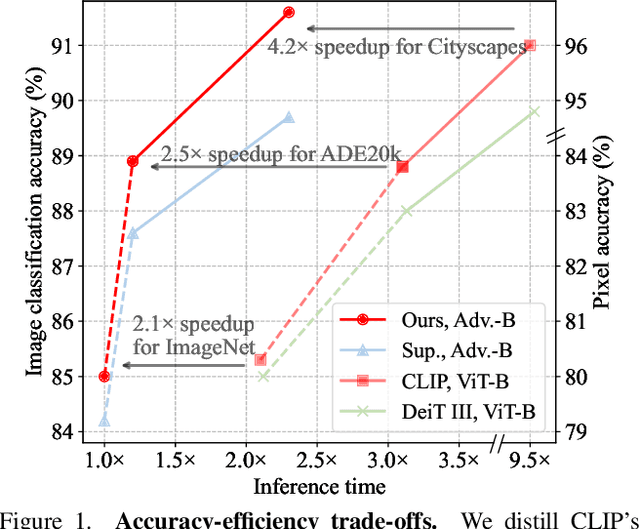

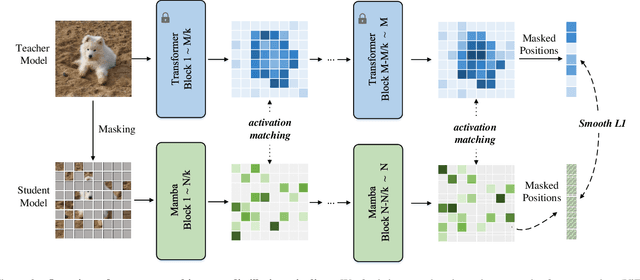

Abstract:Vision Transformers (ViTs) have delivered remarkable progress through global self-attention, yet their quadratic complexity can become prohibitive for high-resolution inputs. In this work, we present ViT-Linearizer, a cross-architecture distillation framework that transfers rich ViT representations into a linear-time, recurrent-style model. Our approach leverages 1) activation matching, an intermediate constraint that encourages student to align its token-wise dependencies with those produced by the teacher, and 2) masked prediction, a contextual reconstruction objective that requires the student to predict the teacher's representations for unseen (masked) tokens, to effectively distill the quadratic self-attention knowledge into the student while maintaining efficient complexity. Empirically, our method provides notable speedups particularly for high-resolution tasks, significantly addressing the hardware challenges in inference. Additionally, it also elevates Mamba-based architectures' performance on standard vision benchmarks, achieving a competitive 84.3% top-1 accuracy on ImageNet with a base-sized model. Our results underscore the good potential of RNN-based solutions for large-scale visual tasks, bridging the gap between theoretical efficiency and real-world practice.
Video-ColBERT: Contextualized Late Interaction for Text-to-Video Retrieval
Mar 24, 2025Abstract:In this work, we tackle the problem of text-to-video retrieval (T2VR). Inspired by the success of late interaction techniques in text-document, text-image, and text-video retrieval, our approach, Video-ColBERT, introduces a simple and efficient mechanism for fine-grained similarity assessment between queries and videos. Video-ColBERT is built upon 3 main components: a fine-grained spatial and temporal token-wise interaction, query and visual expansions, and a dual sigmoid loss during training. We find that this interaction and training paradigm leads to strong individual, yet compatible, representations for encoding video content. These representations lead to increases in performance on common text-to-video retrieval benchmarks compared to other bi-encoder methods.
Recovering Pulse Waves from Video Using Deep Unrolling and Deep Equilibrium Models
Mar 21, 2025Abstract:Camera-based monitoring of vital signs, also known as imaging photoplethysmography (iPPG), has seen applications in driver-monitoring, perfusion assessment in surgical settings, affective computing, and more. iPPG involves sensing the underlying cardiac pulse from video of the skin and estimating vital signs such as the heart rate or a full pulse waveform. Some previous iPPG methods impose model-based sparse priors on the pulse signals and use iterative optimization for pulse wave recovery, while others use end-to-end black-box deep learning methods. In contrast, we introduce methods that combine signal processing and deep learning methods in an inverse problem framework. Our methods estimate the underlying pulse signal and heart rate from facial video by learning deep-network-based denoising operators that leverage deep algorithm unfolding and deep equilibrium models. Experiments show that our methods can denoise an acquired signal from the face and infer the correct underlying pulse rate, achieving state-of-the-art heart rate estimation performance on well-known benchmarks, all with less than one-fifth the number of learnable parameters as the closest competing method.
 Add to Chrome
Add to Chrome Add to Firefox
Add to Firefox Add to Edge
Add to Edge